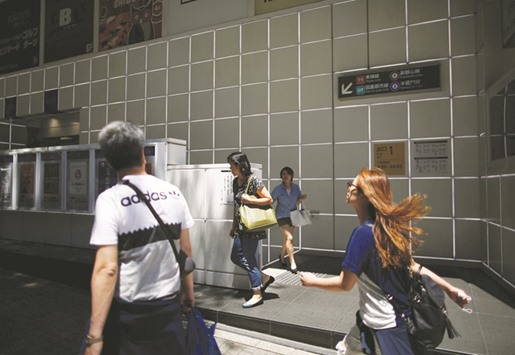Japan’s government approved an economic growth strategy yesterday that failed to show how it will plug a hole in finances caused by delaying a sales tax increase, raising fears that an already alarmingly high public debt burden will worsen.
The strategy will raise wages for low-income earners and improve access to day care, but many of these policies were flagged earlier this year and economists have said they were not enough to narrow income disparity or address economic pressures building due to Japan’s ageing and declining population.
Aggressive structural reforms are essential to pulling Japan out of decades of malaise. But, economists say the flaws in Prime Minister Shinzo Abe’s piecemeal approach are evident in the lack of progress made after more than three years of “Abenomics”, the name given to his mix of monetary easing, fiscal stimulus and structural reforms.
Critics say the delay in the tax increase due to weak consumption and the Bank of Japan’s failure to slay deflation expectations despite resorting to negative interest rates show policymakers are running out of tools to fix an economy that will face even deeper problems of low growth and high debt as the population ages.
“It has become more difficult to meet our fiscal discipline targets,” Economy Minister Nobuteru Ishihara told reporters after the cabinet approved the plan. “But the prime minister has clearly stated that our policies must change in response to the current situation.”
The growth strategy reiterated a pledge to bring the primary budget balance into surplus by fiscal 2020 to rein in public debt, which is already more than double annual economic output, but did not say how the government would bridge the revenue shortfall caused by the tax increase delay.
Abe has said he will announce a “comprehensive and bold” economic package this autumn, raising concerns he will resort to big spending on infrastructure. Abe shifted his economic agenda this year to focus more on the redistribution of wealth and improving access to day care, partly to prepare for an upper house election on July 10.
Many economists said this shift reflected how little low-income households had benefited from Abe’s earlier attempts to reflate a listless economy.
“The structural reforms that the third arrow of Abenomics promised and which do have potential to sustainably bolster the outlook for growth remain notably absent from the government’s plans,” Moody’s Investors Service said yesterday, as it warned that Abe’s decision to delay a planned sales-tax increase and boost government spending was “credit negative” for Japan.
In December 2014 Moody’s downgraded Japan to A1, four notches above the top rating, with a stable outlook.
Abe’s growth strategy will raise pay for child care workers, raise the minimum wage and improve access to elderly care, but economists say the reforms do not go far enough to change Japan’s two-tier labour market.
While the strategy takes steps to narrow the pay gap between regular and part-time employees, critics say it is still too easy for companies to flout labour laws and suppress pay for part-time workers. Some economists also worry companies could try to lower pay for full-time workers to narrow the pay gap, which would depress overall wage growth.
“There are many granular policies that lack concreteness, though the general direction of these policies isn’t wrong,” said Yuichi Kodama, chief economist at Meiji Yasuda Life Insurance.
“Japan’s biggest problem is the ageing and shrinking of its population and the supply-side weakening that follows from it.”
The government wants to raise the birth rate to 1.8 per woman from 1.4, which is a step in the right direction but still below 2.1 – the rate needed to prevent a population from shrinking.

People walk on a street at Shibuya shopping and amusement district in Tokyo. Japan’s government approved an economic growth strategy yesterday that failed to show how it will plug a hole in finances caused by delaying a sales tax increase, raising fears that an already alarmingly high public debt burden will worsen.
